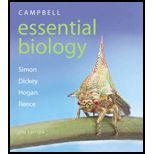
An atom can be changed into an ion by adding or removing ___. An atom can be changed into a different isotope by adding or removing ____.
To determine:
The addition or removal of which sub-atomic particle can change an atom into an ion and an atom into a different isotope.
Introduction:
The atom is the smallest unit of biological organization. However, there are particles even smaller than an atom and such particles together make up the atom. These sub-atomic particles include protons, neutrons, and electrons. In the center of an atom, the nucleus is present. The nucleus is composed of protons (positively charged particles) and neutrons (neutral particles). Electrons (negatively charged particles) revolve around the nucleus in designated orbitals.
Answer to Problem 1SQ
Correct answer:
An atom can be changed into an ion by adding or removing electrons. An atom can be changed into a different isotope by adding or removing neutrons.
Explanation of Solution
An ion is a charged particle formed by the atoms to attain stability. Atoms can either form a positively charged ion called a cation or a negatively charged ion called an anion. Ions are formed by the change in the number of electrons. If electrons are lost, the positive charge on the atom increases. Thereby, an atom changes into a cation. If electrons are gained by the atom, the atom becomes negatively charged. Thereby, an atom changes into an anion. For example, the sodium (
Isotopes are variants of the same element but with different masses. The mass of an atom is contributed by the masses of protons and neutrons in the nucleus. If the number of protons is changed, the element will change. The change in the number of neutrons in the nucleus of an atom leads to the formation of an isotope. For example, the isotopes of hydrogen (zero neutrons) include protium (zero neutrons), deuterium (one neutron), and tritium (two neutrons).
The change in the number of electrons and neutrons leads to the formation of an ion and an isotope, respectively.
Want to see more full solutions like this?
Chapter 2 Solutions
Campbell Essential Biology Plus Mastering Biology with eText -- Access Card Package (6th Edition) (Simon et al., The Campbell Essential Biology Series)
Additional Science Textbook Solutions
Campbell Essential Biology with Physiology (6th Edition)
Concepts of Genetics (12th Edition)
Laboratory Manual For Human Anatomy & Physiology
Human Biology: Concepts and Current Issues (8th Edition)
- Atoms that vary in the number of neutrons found in their nuclei are called _____________. ions neutrons neutral atoms isotopesarrow_forwardWhat atom has only one proton? a. hydrogen c. a free radical b. an isotope d. a radioisotopearrow_forwardAn isotope of sodium (Na) has a mass number of 22. How many neutrons does it have? a. 11 b. 12 c. 22 d. 44arrow_forward
- A nitrogen atom has 7 protons, and the most commonisotope of nitrogen has 7 neutrons. A radioactive isotopeof nitrogen has 8 neutrons. Write the atomic number andmass number of this radioactive nitrogen as a chemicalsymbol with a subscript and superscript.arrow_forwardan atom whose number of electrons does not equal its number of protons is called... ion isotope compound elementarrow_forwardAn isotope of sodium (Na) has a mass number of 22 and an atomic number of 11.how many neutrons does it have? 11 12 22 44arrow_forward
- The name given to the atomic particle found outside the nucleus of an atom isa. proton.b. neutron.c. electron.d. ion.arrow_forwardThe mass number of an atom depends primarily on the number of protons and neutrons. positrons. neutrons and electrons. protons and electrons.arrow_forwardElement Atomic Number Mass Number Number of Protons Number of Neutrons Number of Electrons Carbon-12 12 6 Nitrogen-14 7 7 Chlorine-35 35 17 Oxygen-16 8 Carbon-14arrow_forward
- A sodium atom has 11 protons and 12 neutrons. What is the atomic number of sodium? Multiple Choice A. 34 B. 12 C. 23 D. 11arrow_forwardThe atomic number of an atom is determined by the number of in the atom. (a) protons (b) neutrons (c) electrons (d) electrons plus neutrons plus protonsarrow_forwardIf an atom has an atomic number of 6 and an atomic mass of 14, that means it must have _____ protons.arrow_forward

 Biology 2eBiologyISBN:9781947172517Author:Matthew Douglas, Jung Choi, Mary Ann ClarkPublisher:OpenStax
Biology 2eBiologyISBN:9781947172517Author:Matthew Douglas, Jung Choi, Mary Ann ClarkPublisher:OpenStax Concepts of BiologyBiologyISBN:9781938168116Author:Samantha Fowler, Rebecca Roush, James WisePublisher:OpenStax College
Concepts of BiologyBiologyISBN:9781938168116Author:Samantha Fowler, Rebecca Roush, James WisePublisher:OpenStax College



